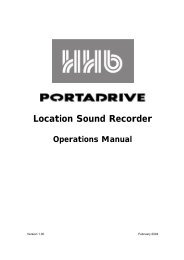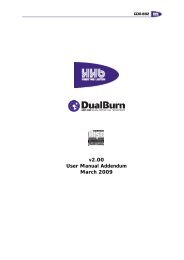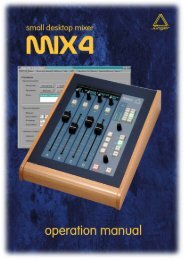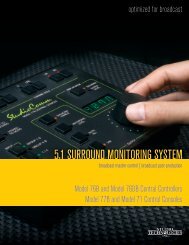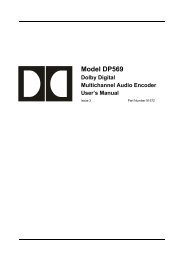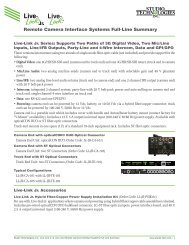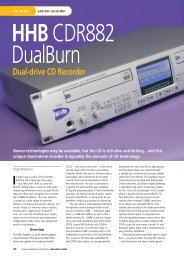WMS 450_korr_5.0
WMS 450_korr_5.0
WMS 450_korr_5.0
You also want an ePaper? Increase the reach of your titles
YUMPU automatically turns print PDFs into web optimized ePapers that Google loves.
3 General<br />
8 Infrared emitter: Transmits frequency data from the receiver to the handheld or bodypack<br />
transmitter. It also transmits the audio gain setting selected on the receiver to the<br />
handheld transmitter.<br />
The infrared emitter has a very narrow radiation angle (approx. 10°) and a maximum<br />
range of 8 inches (20 cm) to make sure only one transmitter will be tuned to the same<br />
frequency.<br />
9 Output level control: This retractable rotary control attenuates the level of the balanced<br />
audio output continuously by 0 to 30 dB.<br />
Refer to fig. 2 on page iii.<br />
Rear Panel<br />
10 DC IN: Locking DC input for connecting the included power supply.<br />
11 ANTENNA A/B: BNC sockets for connecting the two supplied UHF antennas (11a) or<br />
optional remote antennas.<br />
12 BALANCED: Balanced 3-pin XLR audio output for connecting to, e.g., a microphone<br />
input on a mixing console.<br />
13 UNBALANCED: Unbalanced 1/4" TS audio output jack for connecting to, e.g., a guitar<br />
amplifier.<br />
14 Output level switch: Slide switch for matching the BALANCED output level to the input<br />
gain of the equipment connected to the receiver. The switch has two positions, 0 and<br />
-30 dB. The UNBALANCED output level is not adjustable.<br />
15 Type plate indicating available carrier frequency ranges and approval information.<br />
Handheld Transmitter<br />
Refer to fig. 3 on page v.<br />
16 Microphone element: The handheld transmitter uses a permanently attached D 5 or<br />
C 5 microphone element (see packaging).<br />
17 Infrared sensor: Receives the infrared signal emitted by the receiver for automatically<br />
setting the transmitter's carrier frequency and audio input gain.<br />
18 LCD display: Indicates the selected frequency in MHz or as a Preset subchannel, current<br />
mode, transmitter audio gain setting, error messages, as well as the available battery<br />
capacity in 1-hour increments for dry and 2-hour increments for rechargeable<br />
batteries.<br />
19 ON-MUTE/PRG-OFF: This slide switch provides three positions:<br />
ON: The microphone output signal is fed to the transmitter for transmission to the receiver<br />
(normal mode). The status LED (20) is lit green.<br />
MUTE/PRG: The audio signal is muted.<br />
Sliding the switch to "MUTE/PRG" places the transmitter in programming mode.<br />
To switch the audio signal back on, slide the switch to "ON".<br />
OFF: Power to the transmitter is off. The status LED (20) is dark.<br />
20 Status LED: This bicolor LED indicates the following conditions:<br />
Green: The battery will last for more than one hour, the transmitter is in normal mode.<br />
Red: The battery will be dead in less than one hour and/or the the audio signal is muted.<br />
Flashing red: Error message in the display.<br />
Off: Power to the transmitter is off or the transmitter is in programming mode.<br />
21 Battery compartment for the supplied AA size 1.5 V dry battery or a commercial<br />
1.2 V, ≥2100 mAh NiMH AA size rechargeable battery.22 Charging contacts: The<br />
recessed charging contacts allow you to charge a rechargeable battery on the optional<br />
CU 400 charger without having to remove the battery from the transmitter.<br />
23 Frequency sticker: Sticker attached to the transmitter shaft, indicating the available<br />
carrier frequency range and approval data.<br />
30 <strong>WMS</strong> 470





